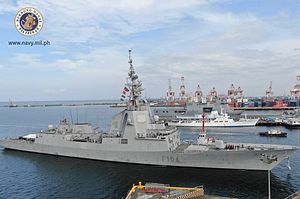Last week, a Spanish vessel paid the first voyage to the Philippines of its kind since the Southeast Asian state’s independence. Though this was just one among several interactions between the two countries which date back centuries, it nonetheless highlighted efforts by both sides to advance the defense aspect of their ties within the contemporary bilateral relationship.
The Philippines and Spain have long shared relations, with Spain having colonized the Philippines for centuries and contemporary diplomatic ties established in 1947. But both sides have also been attempting to further advance their defense ties over the past few years as well, building on aspects such as defense logistics cooperation, training, and the delivery of capabilities for the development of the Philippine military amid its continued modernization.
That has continued on into 2019 as well. Back in June, as both countries commemorated the 17th iteration of Philippine-Spanish Friendship Day, indications were that both sides were planning on finalizing a new defense memorandum of understanding covering various fields including logistics, defense materiel, armaments and defense industry cooperation. There are a number of upcoming engagements as well, including a planned trip for Philippine Navy chief Robert Empedrad to Spain next month, following the visit of the Philippine Army chief to Spain back in June.
Last week, the defense aspect of the relationship was in the headlines with the visit of a Spanish vessel to the Philippines. The air defense frigate Méndez Núñez (F-104) of the Armada Española (Spanish Navy) was in a goodwill visit to the Philippines in what constituted the such interaction of its kind since the end of Spanish rule in the Philippines in the Battle of Manila Bay during the Spanish-American War in 1898. It was part of a broader eight-month voyage to commemorate the 500th anniversary of the circumnavigation of the world by Ferdinand Magellan and Juan Sebastian Elcano, which started in August 1519, and the subsequent arrival of Spain to the Philippines where it ruled for over three centuries.
The goodwill visit featured a series of interactions. Per Maria Christina Roxas, the acting public affairs office director of the Philippine Navy, the Méndez Núñez, an Alvaro de Bazan-class frigate, manned by more than 200 sailors and led by Commander Antonio Gonzalez del Tanago de la Lastra, came into the Philippines through a customary meeting point procedure and then escorted to the berthing area. The visit also saw several engagements, including a welcome ceremony and a port briefing; confidence-building engagements between the PN and Spanish Navy personnel, including a shipboard tour, reciprocal receptions, and friendly games; and a passing exercise between the two sides.
Apart from these activities which are customary for such goodwill visits, there were also a series of interactions meant to commemorate the significance of the historic interaction within the Philippines-Spain relationship – which the Philippine Navy said was an “unprecedented goodwill visit” and marked the first time a Spanish Navy ship “traversed the waters off Cavite and Manila after the post-independence period.”
For instance, the Spanish ship sailed to Baler Bay in Aurora province to honor the Spanish and Filipino soldiers who died in the Battle of Baler – the last stand of Spanish forces in the Philippines. As the Méndez Núñez’s commanding officer told reporters, this was a “unique deployment” designed to commemorate a historical event.
To be sure, this is only one of a series of interactions between the two countries with a long history of ties. And while there may have been a lot of focus on the symbolism of the event, it remains to be seen how such developments will actually translate into substantive gains for the relationship both sides have indicated, be it individual agreements or an increasing role for Spain among other actors within the Philippines’ military modernization. Nonetheless, the notable first highlighted continued efforts by the two countries to make inroads where they can on the defense side as part of their wider contemporary relationship.

































